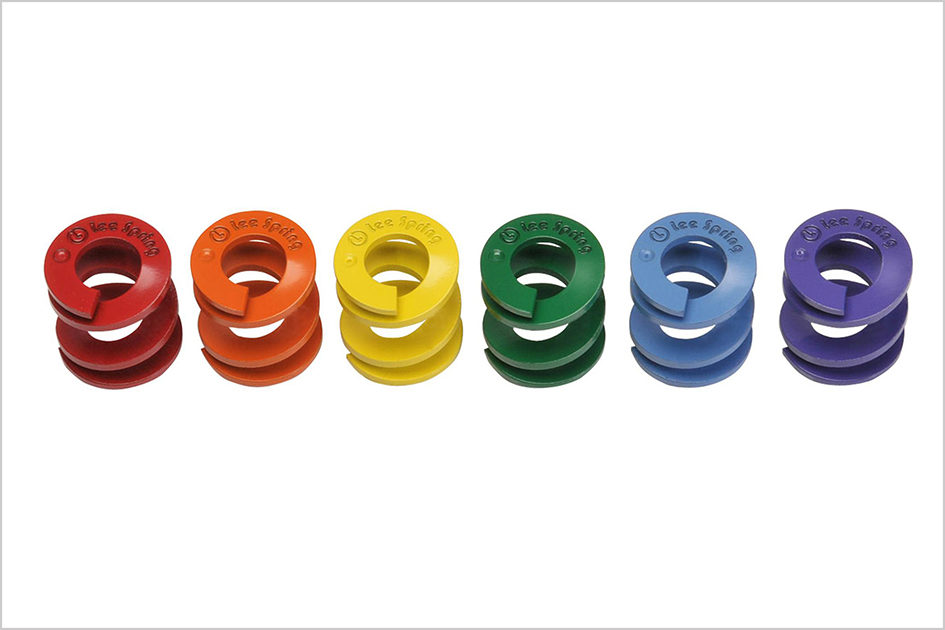The when and why of Plastic springs is rarely a simple matter, made as they are from highly engineered composites and technically advanced new generation materials they are produced with lightweight and high-performance in mind for application in especially demanding industries such as medical, pharmaceutical, electronics, aerospace and similar. Typical properties include operation at elevated temperatures, neutral magnetic characteristics, light weight, low thermal conductivity, electrically insulating and ability to recycle at end of life.
Consequently, Lee Spring have worked very closely with Sabic Innovative Plastics (formerly known as GE Plastics) to select the right material, which led to the adoption of Ultem® resin, a very high-strength plastic, for compression springs ex-stock. Ultem polyetherimide performs in continuous use to 170°C and in the LeeP™ Springs is designed to perform under load with minimum side thrust. This is achieved with a design that has a nearly rectangular cross section to maximize the amount of active material used as opposed to the more common round wire spring design. The exact cross section is a slight trapezoid to facilitate manufacturability. The design element that proved difficult yet critical is the configuration of the ends to provide for minimal side thrust and maximum flat load bearing surface without creating stress points or increasing the solid height while again accounting for manufacturability.
Plastic composite springs offer many advantages including stability of physical and mechanical properties (up to 170°C), high strength to weight ratios and excellent corrosion resistance. The Lee Spring patented design maximises spring rates and cycle life while minimising solid height. The high strength to weight ratio optimises performance while reducing mass. The material is resistant to a wide range of chemicals including acids, alkalis, bases, aromatics and ketones – and being non-magnetic, it does not interfere with imaging or ferro-sensitive technologies. As a dielectric insulating material, it is suitable for non-conductive applications, and being inert and non-contaminating, it protects product purity.
LeeP plastic composite springs are available in five colours, but that’s not simply to be aesthetically pleasing since the colour coding indicates the strength of the individual product, running through red, orange, yellow, green and violet in order from weakest to strongest.
Plastic springs have wide ranging applications in medical products and apparatus, imaging and X-ray equipment, food processing and packaging machinery as well as in the aerospace, marine, electronics, electrical, water purification, chemical, automotive, semi-conductor, instrumentation and communications sectors. Industries where plastic springs offer a number of benefits, Lee Spring developed the LeeP™ Spring concept in response to increased requests for spring products combining the strength offered by metal, with the special attributes of high performing engineered thermoplastics.
In addition, due to minimal flammability and toxicity, LeeP Springs offer a high level of environmental safety while being recyclable, as well as compliant with most Global regulations including RoHS and REACH. At the same time they offer high strength to weight ratios and the precision of the plastics moulding process enables performance to be optimised while reducing mass.
So where considering replacing metal springs with plastic it is important to understand their characteristics – for example LeeP™ Springs have been carefully designed to meet various specific spring application requirements that require the spring to be inert, non-corrosive and non-metallic for installations plastic LeeP™ springs offer numerous advantages. For example, LeeP springs offer high strength to weight ratios, which help to optimise performance whilst reducing mass and providing high corrosion resistance. Because of the non-corrosive, non-metallic and high strength properties offered by plastic LeeP™ springs, some applications particularly well suited to include aerospace products, marine products, electronics and electronic equipment, water purification systems, chemical environments, communication devices, imaging and X-Ray equipment and cosmetics packaging equipment.
Further information on Lee Spring products can be found on their website – www.leespring.co.uk or by following them on Twitter – https://twitter.com/leespringuk.







